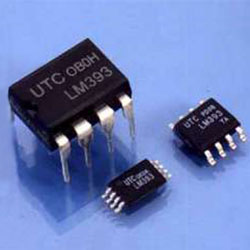
Differential or Balanced Amplifiers
Using differential or balanced amplifiers doubles your dynamic range. Operating in the same manner as a “bridged” power amplifier, the two terms are used interchangeably and mean the same thing.
Bridging is the name given to the technique of driving one channel of a stereo power amplifier with the input signal and simultaneously driving the second channel with an inverted (polarity reversed) input signal.
The loudspeaker is connected to the two hot terminals (normally red colored) instead of the normal connection of hot and ground (red & black).
This doubles the output voltage across the loudspeaker and theoretically quadruples the power (twice the voltage draws twice the current, and since power equals voltage times current, then the power is increased four times), but usually the power supply cannot deliver the twice-current requirement so typically a bridged amp only puts out a little more than twice the rated power.
Audio designers use the term “balanced” while their instrumentation colleagues use “differential.” Either way the signal exists between two equal impedance lines, instead of between one line and a ground.
The amplifier drives the lines in a push-pull manner, simultaneously driving one positive and the other negative, consequently doubling the level. For example, if a normal single output amplifier drives its single output line positive to 1.0 volt, a differential amplifier would drive its positive line to 1.0 volt and its negative line to 1.0 volt yielding a net instantaneous voltage level of 2.0 volts. This doubling gives 6 dB more headroom—a very significant dynamic range increase.
Balanced techniques avoid grounding and return noise problems, lowers distortion since push-pull operation suppresses even-order harmonics, and minimizes electromagnetic interference (EMI).
Most high quality audio D/A converters have differential outputs—one of their tricks for better dynamic range and S/N specifications. Differential output D/As allow using bridging techniques for the analog audio outputs.
Likewise, at the input end of things, analog audio input stages should be designed for balanced differential inputs, and use differential processing all the way to the A/D converter. This applies to all inputs: microphones, sensors, line-level stages, and so on.
Finding audio-grade ICs with balanced/differential inputs or outputs is easy (of course, all op amps have differential inputs but chips specialized as mic preamps & instrumentation amplifiers are of particular interest on the input side and balanced/differential line drivers on the output side; available from Analog Devices, TI/Burr-Brown, and others).
But finding fully balanced/differential inputs and outputs is quite difficult. A fully differential amplifier is defined by Texas Instruments35 as one with differential inputs and outputs, and whose differential structure rejects coupled noise at the input, at the output, and at the two power supply pins.
The parts exist, but they are designed for video and communications applications, not for audio.
Therefore their use demands caution regarding specifications (e.g., some are not unity gain stable, and/or exhibit high noise performance due to the extreme bandwidths) and application (e.g., high frequency circuit layout design techniques are necessary to achieve the highest performance, as well as the use of surface-mount passive components for low lead inductance and small size allowing short runs).
Low voltage differential devices are available from a growing number of sources. Some recent parts to look over, if for no other reason than to get you thinking in this direction are available from Analog Devices (AD8138) and of particular interest is a newcomer from Texas Instruments (THS4131, also from TI is an excellent application note on new technology differential amplifiers).
What makes the THS4131 interesting is its unity-gain stability and the fact that the input noise is specified all the way down to 10 Hz (most high-speed amplifier data sheets only spec things down to 1 MHz) with an incredible 10 kHz spot noise of only 1.3 nV per square-root-Hz (typ).
